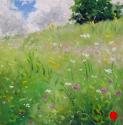
I don't know anyone who doesn't like lavender. I, for one, love it! It is an herb that has been used for various reasons for centuries. It is said to relieve fatigue, depression and tension headaches...not to mention how wonderful it smells!
Lavender was used in ancient Egypt for embalming, cosmetics, massage oils and medicines; only to be used by royal families and high priests. It was even found in the tomb of Tutankhamen. Wealthy men would put solid cones of lavender ungent on their heads that would melt by their body heat and cover them in perfume. The Greeks learned much from the Egyptians, but thought it better to be put on the lower extremities (such as the feet) so that the smell would rise and envelope the entire body. Ancient Romans recognized lavender for its healing and antiseptic qualities as well as its usefulness in deterring insects. They used it often in washing. The Arabs passed down their knowledge of lavender (of which they learned from the Romans and Greeks) to Spain, where it spread through the rest of Europe. Some of the first varieties of lavender are thought to be domesticated in Arabia.
In the Dark Ages, lavender was mostly used by the monks and nuns whose monasteries preserved the knowledge of herbal lore in their physics gardens. They copied ancient manuscripts and recorded the medicinal effects. Under an order from the Holy Roman Empire in 812 AD, the monks and nuns were charged with growing vegetables, medicinal plants, flowers and trees. Lavender was one of the herbs listed to be grown at Merton Abbey...which was later to become the center of lavender production in England - Mitcham. The herb is first mentioned in 1301 in Merton Prioriy's records as being used to raise money for King Edward I. Later when King Henry VIII dissolved the monasteries, lavender moved to domestic gardens where it was used to freshen the air, placed among linens, sewn into sweet bags, and mixed with beeswax to make a furniture polish. It was traditionally grown near the laundry where linens and clothing were laid over the plants to dry while absorbing the wonderful fragrance. It was also used to repel insects. Queen Elisabeth loved lavender and often used it in a tea to treat her migraines and as a perfume. Henrietta Marie, wife of King Charles I and who is accredited to bringing cosmetics to the English court, used lavender in perfumed soaps, potpourris, and in the bath and wash water. King Charles IV of France would have his seat cushions stuffed with Lavender.
Later, in 16th century France, lavender was regarded as an effective and reliable protection against infection. Glove makers who were licensed to perfume their wares with lavender often seemed to escape cholera! By the 17th Century, lavender was found in most gardens and was considered a "cure all".
In the Victorian Era, Queen Elizabeth was a great enthusiast in the use of lavender. It became so popular with the ladies that young women would often wear small bags of lavender in their cleavage in hopes of attracting a suitor. Lavender appeared in the London Pharmacopeia. Mitcham, a London suburb, was the center of lavender oil production and english lavender products became known all over the world. However, with the increasing land values in Mitcham and surrounding areas, lavender production nearly died out. The Shakers grew lavender commercially and used it in gift items and medicines.
In the modern day, lavender oil has been used to dress war wounds during World War 1. Provence is now the world's largest lavender producing region. Just before World War 1, the French government saw lavender production as a means to keeping people from leaving the area, so they cleared the almond orchards and planted lavender.
Today, lavender is used to induce sleep, ease stress and relieve depression. It can be used in a tea, to treat wounds and burns, and can be applied to the forehead to relieve congestion and sinuses, headaches, hangovers, fatigue, tension and exhaustion.
WOW! What an alternative to the present day chemicals that we are putting in our bodies!





